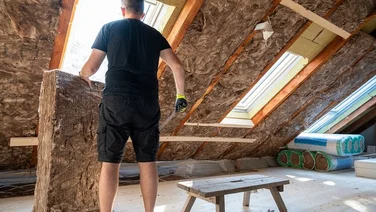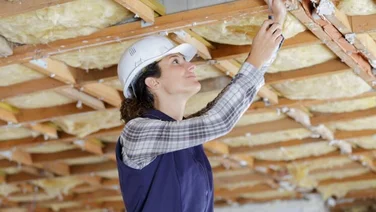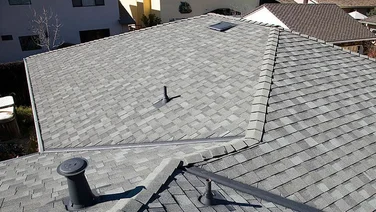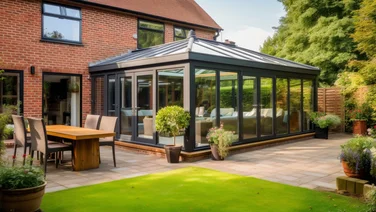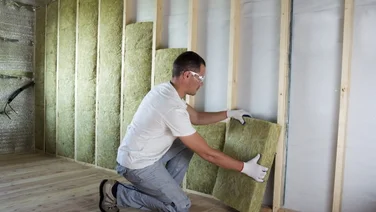- 1. It’s not suitable for all homes
- 2. It won’t be effective if it’s installed incorrectly
- 3. It won’t work if the property has any cracks
- 4. It can sometimes damage the property
- 5. It can lead to inadequate ventilation
- How to avoid cavity wall insulation issues
- How to fix cavity wall insulation problems
- Summary
- Some types of cavity wall insulation can cause damage to the property
- Walls with a cavity of less than 40mm wide aren’t suitable for insulation
- Walls exposed to heavy rainfall also aren’t suitable for cavity wall insulation
Spray foam insulation can cause some issues, but this is the same with all types of insulation, including cavity wall insulation.
That doesn’t mean you should skip out on insulation all together. By insulating a property, you can shrink its carbon footprint and reduce household energy bills.
You can’t rush the process of installing insulation – unless you want shoddy retrofitting and higher costs in the long run.
But in this guide, we’ll explore the top five issues surrounding cavity wall insulation below.
If you’re interested in gathering insulation quotes, simply pop your details into this form and our trusted installers will get back to you.
Get free insulation quotes
Answer a few quick questions, and our trusted installers will send you bespoke insulation quotes – for free.
1. It’s not suitable for all homes
Generally, walls with a cavity of less than 40mm wide or more than 12 metres high aren’t suitable for cavity wall insulation, as the insulation won’t spread as easily – resulting in cold spots.
Walls that are exposed to heavy rainfall and wind also won’t be suitable for cavity wall insulation, as they have a higher risk of causing dampness inside the properties. This is because cavity walls weren’t originally designed to have objects in their crevice. In these particularly rainy areas, the water can use the insulation material as a bridge to travel from the outside wall to the interior of the property.
If you’re concerned, we recommend asking for help from a local or national company to advise further.
2. It won’t be effective if it’s installed incorrectly
To make sure insulation is installed effectively, homeowners should get a surveyor to thoroughly check the property before cracking on with the installation process. The surveyor will evaluate whether the property is suitable for cavity wall insulation, and assess how installers should tackle the project effectively.
Insufficient or uneven cavity wall insulation can lead to cold spots in the wall – a process called ‘cold bridging’. This can attract air moisture and lead to issues like black mould, which can cause health problems. It’ll also mean you’ll be reaching for the thermometer more frequently, leading to costly energy bills.
It’s also important for the installer to use the right type of insulation for your house – the first step to avoiding cold bridging. For example, spray foam insulation will work better than fibreglass panels if you have lots of hard-to-reach areas in the cavity wall.
You can find out more about the different types of cavity wall insulation in our helpful guide: The five best cavity wall insulation options for your home.
If you’re worried about poor installation, the best thing to do is monitor your energy bills and analyse how much energy your property is consuming pre- and post-installation. In theory, a new layer of insulation should lower your energy consumption – but a poorly insulated property could have the opposite effect.
3. It won’t work if the property has any cracks
Older properties might not be suitable for cavity wall insulation, as they’re more prone to cracks in the external walls.
If any of the external walls in a property have cracks, the insulation inside won’t be able to withstand severe weather. The rainwater will penetrate the wall, get into the cavity, and will cause damp patches on the interior wall.
If there are only a few minor cracks, it’s worth fixing these before installing cavity wall insulation.
4. It can sometimes damage the property
Some types of cavity wall insulation can cause structural damage to the property – another reason to make sure a surveyor takes a look at the property’s structural soundness before cracking on with the installation.
Bead cavity wall insulation – a grey bonded-bead system that is pressure blown into the cavity by an injection gun – is a key culprit for this issue.
Over-bonded beads can add too much pressure to the walls, causing cracks that could allow water to pass through to the internal wall. This can end up costing the homeowner a pretty penny, since the only way to remove over-bonded beads is to completely remove the external wall and rebuild it.
And if the installer uses under-bonded beads, ants can end up creating nests between the beads, which will cause dampness in the property because of the soil’s ability to absorb moisture from the external wall.
5. It can lead to inadequate ventilation
If you want to keep your home mould free, you need to have good ventilation.
To maintain good airflow in your property with this type of insulation, your installer should fit additional ventilation where necessary. Some installers even do this as part of their standard package.
Homeowners can also reduce the risk of damp issues by opening windows and using extractor fans.

How to avoid cavity wall insulation issues
The first step you need to take is to hire a surveyor to check your property. This assessment will look at whether your property is suitable for cavity wall insulation, and will analyse the building’s structure and its exposure to heavy wind or rainfall.
Once you get the go-ahead from the surveyor, you’ll need to choose a certified installer to carry out the work.
Issues with this insulation can take a few years to fully come to light, but it’s worth keeping an eye out for the following signs to track how effective your insulation has been:
- Condensation
- Damp
- Mould
- Damaged brickwork
- No noticeable increase in warmth inside the property
How to fix cavity wall insulation problems
If you have issues with your insulation, there are still a few things you can do.
Your first port of call should be to check if you have a warranty contract with the supplier or installer. A lot of installers offer a guarantee covered by the Cavity Insulation Guarantee Agency (CIGA), which will mean they’re liable for any damage caused to your property and are contractually obligated to sort it out.
Surveyors who incorrectly recommend insulation for a property can also be liable to cover repair or replacement costs.
If your installer did not offer a guarantee, you can either top up the insulation – for example, if there are cold spots – or have it removed. However, a specialist will need to remove the cavity wall insulation, which involves removing bricks from the wall, vacuuming out insulation, and thoroughly checking the cavity to ensure it is free of debris – and can cost between £1,600 and £2,500.
Summary
- Adding insulation to your property can dramatically shrink your carbon footprint and reduce your bills
- You need to make sure it’s installed properly. If not, it could land you with damage and repair costs further down the line
- Your first port of call should be to check if you have a warranty contract with the supplier or installer
- The first step you need to take is to hire a surveyor to check your property
- Think your home would be suitable for a layer of insulation? If a surveyor approved your property for cavity wall insulation, find out how much spray foam insulation will cost you by popping your details into this form.


